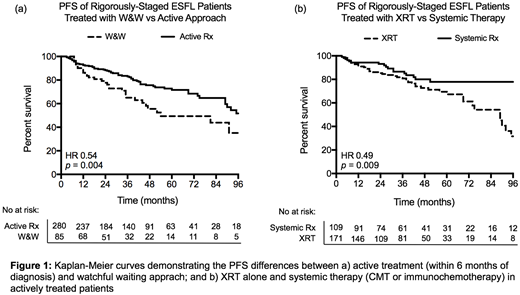Abstract
Background
Stage I/II or early-stage follicular lymphoma (ESFL) is considered potentially curable with radiotherapy (XRT). While XRT does achieve local disease control in >90% of cases, more than half the patients (pts) relapse by 10 years (yr), generally outside of the radiation field.
A recent randomized controlled trial (TROG 99.03) demonstrated that combined modality therapy (CMT), with sequential XRT and systemic therapy, significantly improved PFS but not overall survival (OS) compared to XRT alone in ESFL. However, only half the pts were staged with 18F‐FDG positron emission tomography and computed tomography (PET) and 58% of CMT pts did not receive rituximab.Compared with CT staging, 20-60% of cases are upstaged by PET. Consequentially, there are limitations in applying this trial to modern populations.
Despite the support of current guidelines, only one third of pts in clinical practice are treated with XRT. This suggests a need to better understand the role of other treatments, including watchful waiting (WW), in the PETera. Our aim was to compare outcomes with real-world treatment approaches in rigorously staged ESFL patients.
Methods
We conducted an international, multicenterretrospective study of stage I and II FL pts rigorously staged with bone marrow biopsy and PET. Eligible pts were >18yr with newly-diagnosed grade 1-3A FL and ≥3 months follow up. Primary outcome measures were overall response rate (ORR), progression free survival (PFS), OS and risk of transformation. Survival curves were estimated with the Kaplan-Meier method and uni- and multi-variate analysis was performed using Cox regression model.
Results
A total of 387 pts treated at 13 Australian and 3 Canadian centres between 2005-2017 were studied. Median follow-up was 45 months (range 3.1 - 164.0).5-yrPFS and OS rates were 73.5% (95% CI 66.0-78.5) and 94.4% (95% CI 89.4-93.6) respectively. 22 patients had stage IE duodenal FL with 5-yr PFS and OS rates of 100% and 100% respectively. Considering the unique biology and favorable prognosis of duodenal FL, these cases were excluded from subsequent analyses.
Treatment approaches 365 pts included WW (defined as absence of treatment within 6 months from diagnosis) (23.2%), XRT (46.8%), immunochemotherapy (17.2%) and CMT (12.6%). Treatment regimens were: R-CHOP (48.1%), R-CVP (24.4%), BR (9.9%), other (17.6%). First-line therapies for actively treated pts yielded comparable ORRs of 95.6%, 96.7% and 95.9% for XRT, immunochemotherapy and CMT, respectively (P=0.94). Overall, 18.2% of pts relapsed at distant sites, 88.2% of all relapses.
Treatment cohorts differed in baseline clinical characteristics. WW pts were significantly older (P=0.007) but otherwise comparable to those treated actively. Compared to chemotherapy or CMT pts, those treated with XRT had more favorable features including fewer B symptoms (4.2% vs 11.2% p=0.029), bulk (≥7cm) (6.8% vs 25.3%, p<0.001), nodal sites (≥3) (1.9% vs 9.5% p=0.005) and a higher frequency of stage I FL (73.1% vs 42.1% p<0.001).
Outcomes differed among treatment approaches. Active treatment was associated with superior PFS compared with WW pts (HR 0.54 p=0.004) however, 49.4% of WW pts remained untreated at 5-yrs (Fig 1a). Considering actively treated pts, systemic therapy (immunochemotherapy or CMT) was associated with superior PFS compared to XRT by univariate analysis (HR 0.49, p=0.009) (Fig 1b). This association remained after multivariate adjustment for bulk, B symptoms, nodal sites and stage (HR 0.41 p=0.002). Treatment with immunochemotherapy and CMT demonstrated a comparable PFS (p=0.2). Maintenance rituximab (n=45) was associated with superior PFS compared with observation after systemic therapy (HR 0.24, p=0.017). There were no differences in OS among treatment approaches (P=0.734). There was a higher incidence of transformation in XRT pts compared to systemic therapy pts (6.4% vs 1.6% p=0.046).
Conclusion
In the largest assessment of rigorously-staged ESFL pts in the PETera, pts treated with systemic therapy (chemotherapy or CMT) had a superior PFS and a lower rate of transformation compared to pts treated with XRT, although treatments were not randomized. These findings are similar to the TROG 99.03 trial and challenge the paradigm that ESFL should be uniformly treated with XRT alone. Half the pts observed from diagnosis remained treatment-free at 5-yrs, suggesting that WW may be appropriate in selected pts.
Tobin:Celgene: Research Funding; Amgen: Other: Educational Travel. Tam:Roche: Honoraria; Roche: Honoraria; Pharmacyclics: Honoraria, Travel funding; Pharmacyclics: Honoraria; Beigene: Honoraria, Other: Travel funding; Beigene: Honoraria, Other: Travel funding; AbbVie: Honoraria, Research Funding; Janssen: Honoraria, Research Funding; Gilead: Honoraria; Gilead: Honoraria; AbbVie: Honoraria, Research Funding. Abro:Amgen: Other: education support congress attendance; Celgene: Other: education support congress attendance; Bristol-Myers Squibb: Speakers Bureau; Janssen: Other: education support congress attendance; Novartis: Consultancy. Hawkes:Bristol Myers Squibb: Other: Speaker fee, Research Funding; Takeda: Other: Speaker fee; Astra Zeneca: Research Funding; Merck Sharpe Dohme: Research Funding; Merck KGA: Research Funding; Celgene: Other: Advisory board, Research Funding; Merck: Other: Advisory board; Roche: Other: Speaker fee; advisory board. Talaulikar:Amgen: Consultancy, Honoraria; Roche: Honoraria, Speakers Bureau; Janssen: Honoraria, Speakers Bureau; Takeda: Research Funding; Novartis: Honoraria, Speakers Bureau. Gandhi:Celgene: Membership on an entity's Board of Directors or advisory committees, Research Funding; Janssen: Honoraria, Membership on an entity's Board of Directors or advisory committees; Merck: Honoraria, Membership on an entity's Board of Directors or advisory committees; Amgen: Honoraria; Takeda: Honoraria; Gilead: Honoraria, Membership on an entity's Board of Directors or advisory committees, Research Funding; BMS: Membership on an entity's Board of Directors or advisory committees, Research Funding.
Author notes
Asterisk with author names denotes non-ASH members.


This feature is available to Subscribers Only
Sign In or Create an Account Close Modal